Determine the cause
So, if the leaves of houseplants turn yellow, first of all find the cause. The conditions of maintenance have not changed (the heating has not been turned on, the house has not become cold, the pot has not been moved), but the leaves have started to fall? Most likely, this is seasonal yellowing of the leaves and there is no need to fight it.
But just in case, check the leaves and stems for the presence of eaters: aphids are visible on the underside, spider mites’ webs are in the internodes, scale insects are almost all over the surface. Gnats and slugs can live in the soil – if the soil is garden or greenhouse, it must be treated with special preparations.
To find other, less obvious reasons, compare the conditions in your home with the recommendations for caring for a specific houseplant according to the following instructions:
- Is there sufficient lighting?
- Does the flower suffer from a lack or excess of moisture?
- Is it time to start feeding or replanting?
- What kind of water is used for watering?
- Is the soil composition correct?
- Are there drainage holes or a drainage layer in the pot?
Once the exact cause of yellowing is found, we proceed to its elimination.
Many houseplants are naturally designed to get rid of old or extra leaves: for example, when the foliage of a rose, hibiscus, ficus dies, a new one appears in its place.
Incorrect watering
The problem can appear from two sides – overwatering and insufficient watering. With incorrect watering, the root system is disrupted, which leads to a disruption in the nutrition of the plant itself and foliage.
When the roots of the plant are constantly in water, rot and other diseases develop, leading not only to yellowing, but also to the death of the green pet. And during a drought, the plant will simply dry out due to dehydration.
See how to make automatic watering so that the houseplant does not wither during the holidays.
How to fix watering?
To determine the watering rate, focus on the requirements of your plant – there are no universal recommendations.
But there are general recommendations for choosing water and watering technique:
- use water at room temperature;
- choose either fresh or settled (let it stand for 2-3 days);
- avoid watering with chlorinated or hard water.
- drain excess water from the tray;
- evenly moisten the entire soil;
- water in the required way (each plant has its own – under the root or in the tray)
Over-watering is solved by neutralizing stagnant water, drying the earthen lump and subsequent regular spraying and systemic moistening.
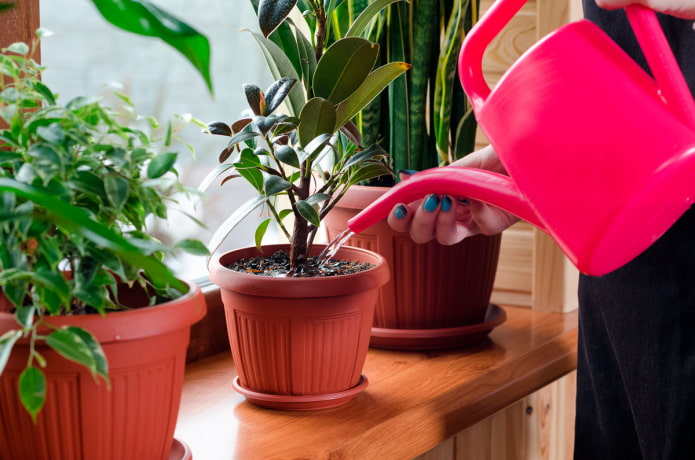
Insufficient or excess lighting
Direct sunlight is the most common cause of yellowing of the leaves. But lack of light will weaken the plant, which will also lead to yellowing of the leaves. When lighting is not adequate, secondary symptoms appear, pay attention to them:
- the color of the leaves will become duller;
- the buds will look stunted or will not bloom at all;
- with too much light, in addition to yellow tips, black spots may appear.
How to fix it?
Perhaps the pot with a particular flower is simply in a corner that is too dark, or too light and is suffering from burns. First, study the lighting requirements, and then the solution is as simple as possible:
- too much light – just move it to the shade or shade it
- lack – gradually add additional light with a phytolamp.
And don’t forget to turn the plants (if they need it) to ensure uniform lighting.
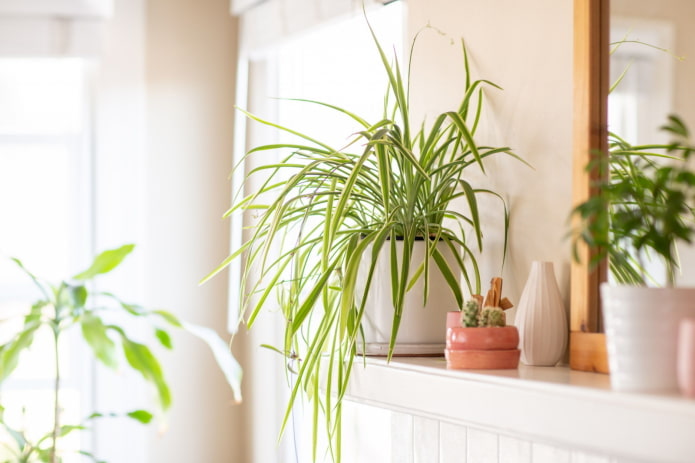
Nutrition deficiencies
The error can manifest itself in two ways – excess or deficiency. A large number of trace elements in the soil leads to the formation of salt deposits, as a result of which the root system is disrupted. And the first symptom is yellowing of the foliage.
With a lack of nutrients, in addition to yellowing, there are other symptoms – the size of the leaves decreases or only a small part of the leaf turns yellow. The most common deficiencies are: nitrogen, magnesium, iron and calcium.
How to fix it?
First, analyze the current situation:
- Look at the recommendations for the care and feeding of your plant;
- Remember how long ago you replanted the flower;
- What kind of water do you use for watering? (if from the tap, then most likely it is hard and perhaps you have an excess)
- When was the last time you fed and how much did it correspond to the recommendations?
Some types of deficiencies can be treated without purchased preparations: for example, with a calcium deficiency (the plant has stopped growing, leaves and buds are falling off), eggshells are crushed and mixed into the soil. The amount of magnesium (the lower leaves turn yellow) is regulated with wood ash. If there is a lack of iron (it starts to turn yellow from the top), you can bury rusty nails in the ground.
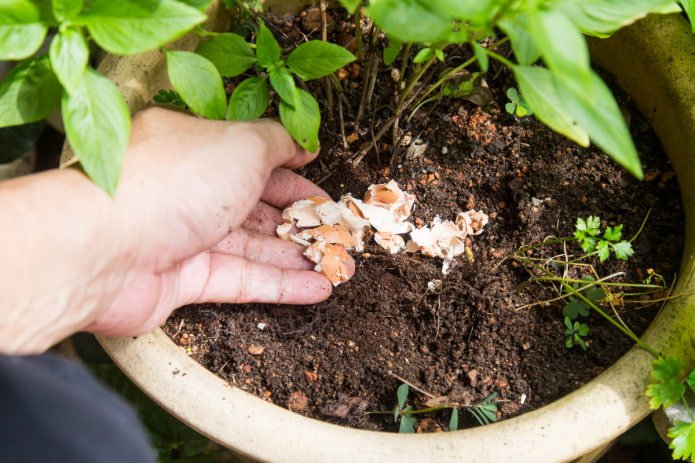
If you have identified a deficiency at a late stage, then use a complex purchased fertilizer. The most popular are: Joy, Agricola, Forte, Fasco, Flower Paradise. But do not immediately give large portions – start gradually and observe the result. After the leaves return to their healthy appearance, make a feeding schedule and try to stick to it.
For excess, there is one simple solution – pour clean water. Take water with a neutral pH level and water the plant generously until the liquid starts to flow out of the holes in the pot. The volume and frequency of watering depends on the level of oversaturation. For example, for a slight excess, you can generally get by with just reducing the portion, and for a serious one, repeat the procedure several times.
Temperature changes and drafts
Most often occurs in winter, when the flower touches the cold glass with its leaves. But a draft can also occur in summer. For example, turn on the air conditioner and put the pot directly under the air flow. When blown, the leaves turn yellow in large quantities and the plant begins to actively shed them.
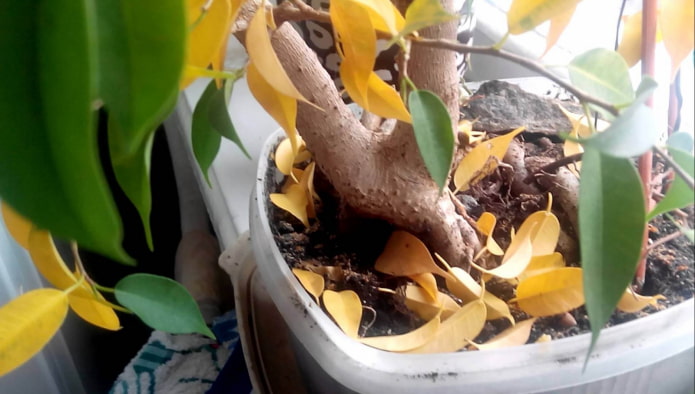
How to fix?
One of the easiest reasons to solve. Help move the plant to another place to avoid temperature changes. The leaves will quickly return to their previous appearance.
Pests
First, inspect the plant from all sides, including the soil.
First of all, the affected indoor flower is moved away from others: isolation will help protect green neighbors.
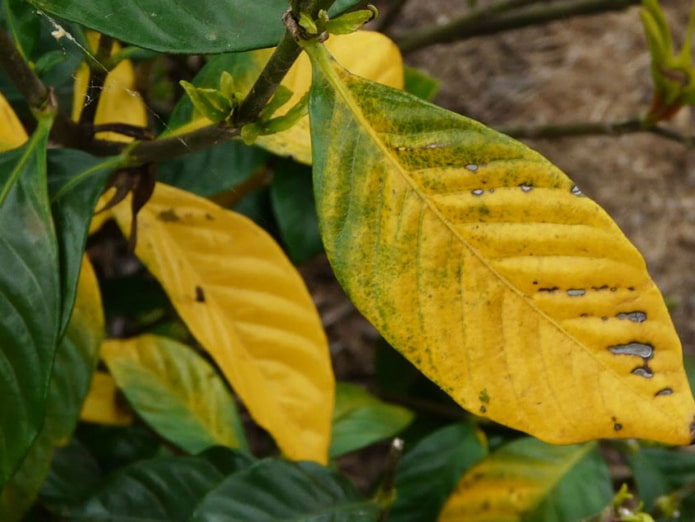
How to fix?
If you find pests and their small number, then you can first try folk methods.
In most cases, it is possible to save your favorite plants – the main thing is not to delay the start of the process.
See the detailed article on the fight against midges in flowers.
What exactly to treat the soil or shoots with depends on the creature that feeds on the juices of the plant:
- Aphid. An ordinary medium-sized onion is chopped in a blender or on a grater, poured with a liter of water and infused for 12-24 hours. Then the diseased specimen is thoroughly sprayed daily for 7-10 days.
- Gnat. Their appearance is easiest to detect: midges begin to circle above the pot. Proper disposal involves not only killing flying adult individuals, but also larvae (live in the ground). To do this, it is recommended to sprinkle the top layer of soil with ground black pepper or spread the zest of any citrus fruit on it. Over time, the pests will die.
- Scale insect. Since these insects are protected by armor, getting rid of them is the most difficult. Alternatively, you can remove visible individuals manually, and then treat the stems and leaves with a weak solution of acetic acid. Or dilute 1 tbsp in 1 liter of water. liquid soap and rubbing alcohol, whip into a foam and apply the solution to the habitat.
- Spider mite. Soap also has a negative effect on these small eaters: take any sponge, lather, lather – wipe the entire plant from the ground to the top. Or dilute a strong soap solution and spray the flower.
Important! To increase the effectiveness of the above-mentioned products, cover the plant with film after treatment (you can simply put a bag on top). No parasite likes humid “tropical” conditions, the method works without fail. After 12-24 hours, remove the bag, rinse the crown with a strong stream of hot (~40C) water.
If there is no time, then use professional products right away. When working with professional insecticides, it is important to observe the frequency of spraying or watering, dilution proportions.
One of the most effective products is Aktara. It helps to quickly get rid of most harmful insects, so if the case is advanced, start treatment with it.
- Aphids. When the foliage falls from small green parasites, use BI-58, BioExpert, green soap, ExtraFlor. In general, aphids are killed by almost any drug against insects.
- Gnat. To defeat visible and invisible individuals, ExtraFlor (from midges), Mukhoed, Grom-2 will help.
- Scale insect. It is most effective to water with Aktara, BioExpert, BI-58, Doctor, 30 plus will also work.
- Spider mite. The control mode is the same as in the case of aphids – almost any insecticide (BioExpert, green soap). The best option for the home is considered to be the acaricide Sanmite, created specifically to combat mites at any stage of growth.

Diseases
Some diseases can cause yellowing of leaves. These include infectious, viral or fungal diseases.
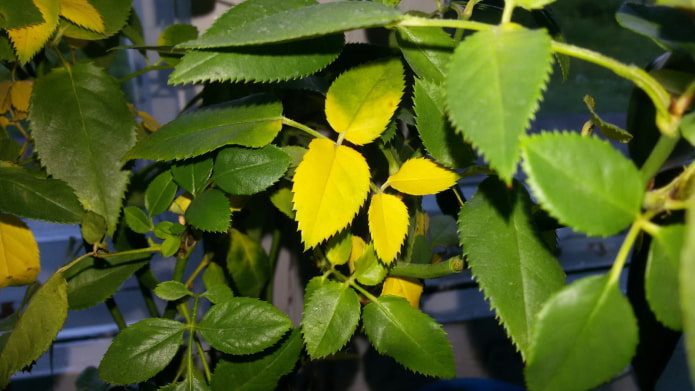
How to fix?
When leaf blades, roots or stems are affected by infection or fungus, a soap solution will not help. But you can use:
- Potassium permanganate. An excellent disinfectant, used when preparing healthy plants for planting or for treatment when the roots are affected by rot. The latter is caused by excess water and lack of drainage.
- Soda. 35 g of soda per 10 l of water – a solution for combating powdery mildew or fungal infections is ready!
- Hydrogen peroxide. Another disinfectant, works like potassium permanganate: treats fungus, rotting.
Important! If a health threat appears – spots on leaves, rot, fungi – plant care begins with removing the affected areas. If the disease begins at the root, the flower will need to be replanted, having previously removed the affected roots and treated the remaining ones with a weak solution of manganese, peroxide or furatsilin.
The more the leaves turn yellow, the faster you need to decide what fertilizer or fungicide is required for treatment.
By starting to use the right medicine in a timely manner, you can save even a neglected flower:
- Rot. Remove the affected roots, spray with zuparen.
- Powdery mildew. Fitosporin-M will help restore a healthy state.
- Rust. This is a fungus, so any fungicide is needed.
- Fungus in the soil. Try gliocladin.
- Bacteriosis. Sporobacterin will help.
As with folk remedies, first remove the affected areas.
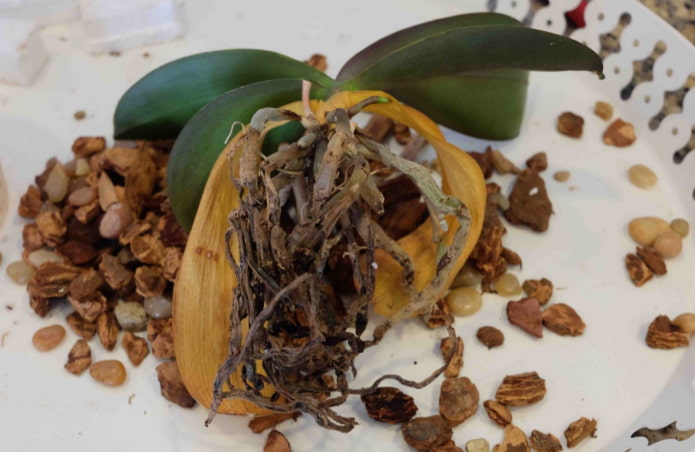
Preventing yellowing
Properly caring for green inhabitants is much easier than treating the consequences of mistakes. To avoid yellowing, follow general advice:
- Watering causes the most problems: always let the water settle, or better yet, use melted or rainwater. Most plants should be watered only after the top layer of soil has dried out.
- Few varieties like the scorching sun: protect flowers from direct sunlight.
- Rarely does a plant (except a cactus, succulent) not like moisture. Ensure sufficient air humidity.
- Regularly apply fertilizer during active growth and flowering (usually from spring to autumn, once every 7-10 days).
- Check flowers for pests at least 1-2 times a month.
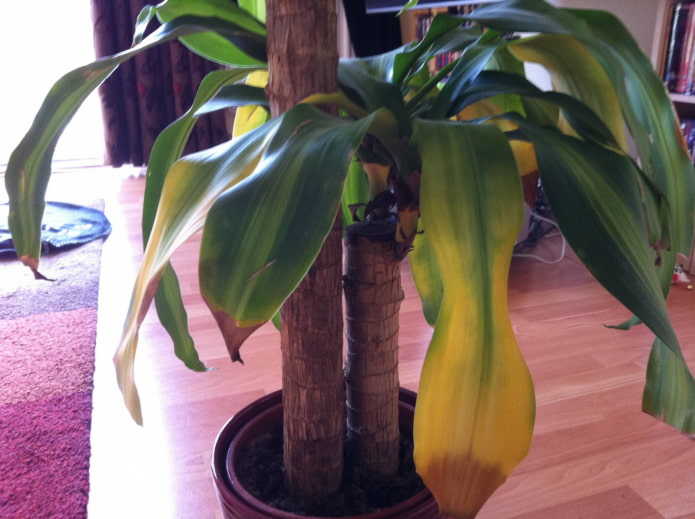
Yellowing of leaves is most likely not a cause, but a consequence of improper care or plant disease. It will pass as soon as you get rid of the original source of the problem.
Now reading:
- Choosing a gate for a country house: types, sizes and design solutions (40 photos)
- Children’s room design ideas 10 sq. m: TOP-50 photos for inspiration
- Ceiling design with clapboard: more than 60 photos and examples in the current direction
- Bunk Beds for Kids: 50+ Ideas and Photos for Boys and Girls
- Light doors for an apartment: 60 photos and stylish design solutions.